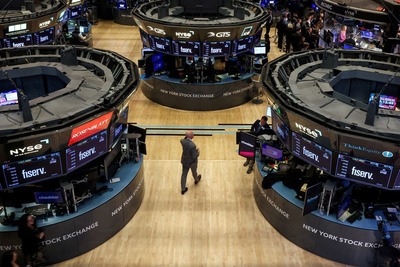Trump tariff tailspin worsens, Nasdaq confirms in bear market

(Reuters) -
The Dow Jones Industrial Average, S&P 500 and the Nasdaq Composite posted their largest two-day declines since the emerging coronavirus caused global panic during U.S. President Donald Trump's first term. For Thursday and Friday, the Dow was down 9.3%, the S&P 500 10.5% and the Nasdaq 11.4%.
Fallout from Trump's sweeping tariffs stoked fears of a global recession, wiping trillions of dollars of value from U.S. companies. Highlighting growing panic among investors, the CBOE Volatility Index, or
Since late on Wednesday, when Trump boosted tariff barriers to their highest level in more than a century, investors have dumped stocks, fearing both the new U.S. economic reality and also how U.S. trading partners might retaliate by steepening their own trade barriers.
A record-breaking number of shares were traded on Friday, with volume on U.S. exchanges around 26.79 billion shares, beating the previous high of 24.48 billion shares traded on
The Nasdaq slid on Friday 962.82 points, or 5.82%, to 15,587.79, confirming the tech-heavy index was in a bear market compared to its record closing high of 20,173.89 on
Meanwhile, the Dow Jones Industrial Average fell 2,231.07 points, or 5.50%, to 38,314.86 points, confirming a correction to its record closing high of 45,014.04 on
The S&P 500 lost 322.44 points, or 5.97%, to close at 5,074.08 points, its lowest finish in 11 months.
"Right now, how bad it gets depends on how committed the administration is to this set of policies which, clearly, the market is voting against," said
Global governments began reacting to Trump's tariff announcement on Friday, further undermining investor sentiment that a global recession could be averted. JP Morgan said it was forecasting a 60% chance of the global economy entering a recession by year-end, up from 40% previously.
"We're in the Wild West of a trade war right now," said
For the week, the S&P 500 fell 9.1%, the Dow declined 7.9%, and the Nasdaq slumped 10%.
Federal Reserve Chair
Safe-haven buying in the bond market sent the yield on the benchmark 10-year Treasury notes to below 4%. [US/]
This pushed U.S. bank stocks down further, with the sector under pressure globally, as the prospect of interest rate cuts from central banks and a hit to economic growth from tariffs would crimp profitability. The S&P Banks index dropped 7.3%.
All 11 S&P sectors dropped by more than 4.5%, with energy the leading laggard for the second straight day, off 8.7%, as companies tracked a 7.3% decline in U.S. crude prices. [O/R]
U.S.-listed shares of Chinese companies dived, with
Companies with exposure to
The chipmakers index sank 7.6%, having declined 9.9% the previous day. The sector is particularly vulnerable to a double tariff whammy as many chip companies design their chips in the U.S., but have them manufactured in
(Reporting by Sruthi Shankar and
(c) Reuters 2025. All rights reserved. Republication or redistribution of Reuters content, including by caching, framing or similar means, is expressly prohibited without the prior written consent of Reuters. Reuters and the Reuters sphere logo are registered trademarks and trademarks of the Reuters group of companies around the world.
Related News

-
Trump's week of tariff turmoil rings recession alarm
Reuters - 2:57 AM ET 4/11/2025
-
Analysis-Investors grapple with tariff-driven economic threat as market swings persist
Reuters - 1:06 AM ET 4/11/2025
-
Trump's tariff confusion could leave aircraft deliveries in limbo
Reuters - 1:04 AM ET 4/11/2025
-
Exclusive-Shein gains UK approval for London IPO, awaits China nod, sources say
Reuters - 2:14 AM ET 4/11/2025
-
JPMorgan analyst says he now tempers public comments on US tariffs
Reuters - 19 minutes ago
-
Tesla stops taking new orders in China for two imported, US-made models
Reuters - 51 minutes ago
-
Exclusive-Facing Trump tariffs, Vietnam eyes crackdown on some China trade
Reuters - 11:51 PM ET 4/10/2025






